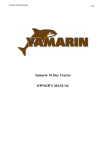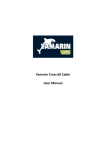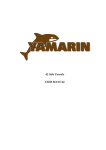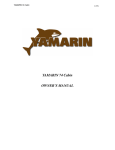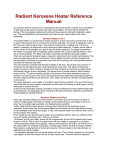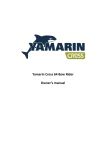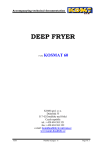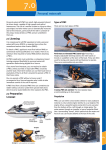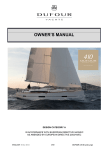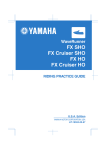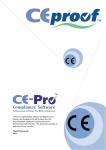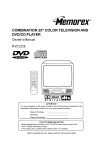Download Yamarin 76 Day Cruiser OWNER`S MANUAL
Transcript
Yamarin 76 Day Cruiser 1 (40) Yamarin 76 Day Cruiser OWNER’S MANUAL Yamarin 76 Day Cruiser 2 (40) FOREWORD Dear Owner of the popular Yamarin 76 Day Cruiser! We thank you for choosing YAMARIN and wish you many pleasant experiences while on the water. The intention of this manual is to help you to operate your craft with safety and pleasure. It contains details of the craft, the equipment supplied or fitted, its systems and information on its operation, care and maintenance. Please read it carefully, and familiarise yourself with the craft before using it. Naturally, owner's manual is not a course on boating safety or seamanship. If this is your first craft, or you are changing to a type of craft you are not familiar with, for your own comfort and safety, please ensure that you obtain handling and operating experience before "assuming command" of the craft. Your dealer or national sailing federation or yacht club will be pleased to advise you of local sea schools, or competent instructors. Ensure that the anticipated wind and sea conditions will correspond to the design category of your craft, and that you and your crew are able to handle the craft in these conditions. The sea and wind conditions corresponding to the design category C where maximum windspeed is 14 m/s and maximum significant wave height is 2 m. Even when your boat is categorised for them, they are dangerous conditions, where only a competent, fit and trained crew using a well maintained craft can satisfactorily operate. This owner's manual is not a detailed maintenance or trouble shooting guide. In case of difficulty, refer to the dealer. Always use trained and competent people for maintenance, fixing or modifications. Modifications that may affect the safety characteristics of the craft shall be assessed, executed and documented by competent people. The manufacturer is not responsible for modifications he has not approved. In some countries a driving licence or authorisation are required, or specific regulations are in force. Always maintain your craft properly and make allowance for the deterioration that will occur in time and as a result of heavy use or misuse of the craft. Any craft – no matter how strong it may be, can be severely damaged if not used properly. This is not compatible with safe boating. Always adjust the speed and direction of the craft to sea conditions. If your craft is fitted with a life raft, read carefully its operating manual. The craft should have onboard the appropriate safety equipment (Lifejackets or Personal Floatation Device) according to the type of craft, weather conditions, etc., these equipments are mandatory in some countries. The crew should be familiar with the use of all safety equipment and emergency manoeuvring (man overboard recovery, towing, etc). Sailing schools and clubs regularly organise drill sessions. Yamarin 76 Day Cruiser 3 (40) All persons should wear a suitable buoyancy aid (Life jacket/Personal Floatation Device) when on deck. We wish you lots of fun and hope you have a good time on board with your Yamarin 76 Day Cruiser! Konekesko Marine P.O.B. 145 FIN-01301 VANTAA Telephone +358 10 5311 www.kesko-marine.com www.yamarin.com PLEASE KEEP THIS MANUAL IN A SECURE PLACE, AND HAND IT OVER TO THE NEW OWNER IF YOU SELL THE CRAFT." Yamarin 76 Day Cruiser 4 (40) Table of contents 1 General 1.1 Declaration of conformity 7 7 2 Definitions 11 3 Warranty 11 4 Before use 11 4.1 Registering 4.2 Insurances 4.3 Training 5 Characteristics and use of your boat 5.1 General 5.2 Basic data Specifications 5.3 5.4 5.5 5.6 5.7 5.8 5.9 5.10 Maximum number of persons Loading Engine and propeller Risk of flooding and stability 5.6.1 Hull and deck thru fittings and closing valves 5.6.2 Stability and buoyancy Risk of fire or explosion 5.7.1 Refuelling 5.7.2 Other fuel burning systems (heater and stove) (optional extra) 5.7.3 Fire protection Main switch and fuses Operation 5.9.1 Controls 5.9.2 Emergency switch 5.9.3 Gearshift and throttle 5.9.4 Adjusting the trim angle 5.9.5 Starting the engine 5.9.6 Driving 5.9.7 Approaching the dock 5.9.8 Use of canopy 5.9.9 Windshield middle door 5.9.10 Steps and cabin sliding door Proper use – other recommendations and guidelines 5.10.1 Man-overboard prevention and recovery 5.10.2 Securing of loose equipment 5.10.3 Respect for environment 5.10.4 Toilet 5.10.5 Use of septic tank 11 11 11 12 12 12 14 15 15 16 16 16 17 18 18 18 19 20 21 21 22 22 22 23 23 24 25 25 25 26 26 26 26 27 27 Yamarin 76 Day Cruiser 5.10.6 5.10.7 5.10.8 5.10.9 Anchoring, mooring and towing Towing Trailer transport Docking 6 Maintenance of boat and equipment 6.1 6.2 6.3 6.4 6.5 6.6 6.7 6.8 Washing and waxing the boat Care instructions for seat cushions Care instruction for canopy Care instructions for windshield Care instruction for remote control Care instructions for steering system Care instructions for electrical components Minor superficial repairs 7 Winter storage 7.1 Measures before winter storage 7.2 Measures before launching 5 (40) 27 28 29 29 30 30 30 31 31 31 31 31 32 32 33 34 8 Lay-out 35 8.1 8.2 8.3 8.4 8.5 35 37 37 38 39 General arrangement Fuel system Steering system Electrical system Wiring diagram Yamarin 76 Day Cruiser 6 (40) BEFORE YOU START Familiarise yourself with this owner’s manual. Always check at least the following items before leaving: − − − − − − − − − - Weather state and forecast Take the wind, waves and visibility into account. Are the design category, size and equipment of your boat, as well as the skills of the skipper and crew adequate for the water area you are aiming to? In high wind and waves the hatches must be closed to prevent water ingression Loading and stability Do not overload the craft, distribute loads appropriately. To avoid impairment of the stability, do not place heavy weights high up. Notice, if people are standing on board it weakens boats stability. Passengers Ensure that there is Personal Floatation Device or Lifejackets for all people on board. Agree about the crew tasks before leaving. Fuel Check that there is enough fuel, also reserve fuel for bad weather etc. Regularly check there is no water in moisture trap. Its located under the fuel filter. Fuel filter should be changed 1-2 times per annum because of engine hours and quality of fuel. Engine and manoeuvring equipment Check function and condition of steering and remote control and do the routine checks required by the owner’s manual of the engine. Check the seaworthiness in other aspects also: no leaks of fuel or water, safety equipment on board etc. Check that bilge water is at a minimum. Boats seaworthiness Check the seaworthiness in other aspects also: no leaks of fuel or water, safety equipment on board etc. Check that there is no bilge water. Fastening of equipment Check that all equipment and heavy items are positioned so that they hold in place also in seaway and hard wind. Notice, the seat cushion may fly over board if they are not fixed properly with press studs. Nautical charts If you are not navigating on totally familiar waters, ensure you have on board nautical charts covering an area large enough? If your boat is equipped with chart plotter learn to use it before you start. Ensure that the plotter charts are latest available. Leaving the berth Agree with the crew, who will release each mooring line etc. Be careful not to let mooring lines or anchoring line to entangle the propeller during manoeuvring. Obligatory equipment Each country has different regulations. Find out what are the needs in Your own area. You will find additional instructions concerning the engine from its separate manual. Own notes Yamarin 76 Day Cruiser 1 7 (40) General The Owner’s manual will help You to familiarise with the properties and features of your new boat, as well as with its care and maintenance. Separate manuals of the installed equipments are attached and are referred to in many sections. You can of course complement this owner’s manual by adding the manuals of the devices which are installed afterwards. There is also space for your own notes in the end of this manual. The craft has a running serial number, CIN-code. The CIN-code is labelled on the hull of the craft under the swimming platform at port side. We recommend You write down the relevant CIN-code in the declaration of confirmity in to this book. When you have affairs with the dealer, please tell the CIN-code and the type of craft. This helps in delivering correct spare parts. 1.1 Declaration of conformity Yamarin 76 Day Cruiser 8 (40) DECLARATION OF CONFIRMITY Recreational Craft • Directive 94/25/EC and 2003/44/EC Manufacturer: Seliö Boats Oy Module used (check): B, EC type examination certificate ----------------------------------------------------------------------------------------------------------------THE DECLARATION IS PLACED ON THE MARKET BY Placed on the market by: Konekesko Oy Marine Address: Vanha Porvoontie 245 Zip code: 01300 City:Vantaa Land: (code):FIN (printed): FINLAND ----------------------------------------------------------------------------------------------------------------NOTIFIED BODY Name:VTT Address: Identification number: 0537 P.O. Box 1000 Zip code:FIN 02044 VTT City: Espoo Land: (code) FIN (printed) SUOMI, FINLAND EC type-examination certificate has been issued VTT-C-0545-10-vene-001-06 ----------------------------------------------------------------------------------------------------------------DESCRIPTION OF THE CRAFT Hull identification number (CIN): - Brand name of the craft: Yamarin Type or number: 76 Day Cruiser Design category: C Type of craft *: 03 Type of hull *: 01 Deck *: 02 Construction material *: 02 Propulsion *: 02 Type of engine *: 01 Maximum recommended engine power (kW): 220,7 Length and beam of hull (m): 7,52/2,60 Draught (m): app. 0,45 * codes on opposite side I declare at my own and sole responsability that the craft mentioned above complies with all applicable essential requirements in the way specified in next page. Peter Krusberg Product Manager, Yamarin 2006 / 10 / 05 Yamarin 76 Day Cruiser 9 (40) Type of craft: 01 sailboat 02 inflatable 03 other: motorboat Deck: 01 decked 02 partly decked 03 open: Type of hull: 01 monohull 02 multihull 03 other: Propulsion: 01 sails 02 petrol engine 03 diesel engine 04 electrical motor 05 oars 06 other: Construction material: 01 aluminium, aluminium alloys 02 plastic, fiber reinforced plastic 03 steel, steel alloys 04 wood 05 other: Type of engine: 01 outboard 02 inboard 03 z or sterndrive 04 other: Yamarin 76 Day Cruiser Essential requirements 10 (40) ISO-standards used Other normative document used General requirements (2) Basic information EN ISO 8666:2002 Hull Identification Number – CIN (2.1) ISO 10087:1996 / A1:2000 Builder’s Plate (2.2) RCD annex I, 2.2 Protection from falling overboard and means of reboarding … (2.3) Visibility from the main steering position (2.4) EN ISO 15085:2003 Owner’s manual (2.5) EN ISO 10240:2004 RSG Guidelines, EN ISO 11591, NBS F10 Structure (3.1) Stability and freeboard (3.2) RSG Guidelines, NBS-VTT Extended rule EN ISO 12217:2002 Buoyancy and floatation (3.3) Openings in hull, deck and superstructure (3.4) Flooding (3.5) Manufacturer’s maximum recommended load (3.6) ISO 9093-1:1994, EN ISO 9093-2:2002, EN ISO 12216:2002 EN ISO 11812:2001, EN ISO 12216:2002, EN ISO 12217:2002, EN ISO 15083:2003, ISO 8849 EN ISO 12217:2002, EN ISO 14946:2001 Liferaft stowage (3.7) RSG Guidelines Escape (3.8) EN ISO 9094-1:2003 Anchoring, mooring and towing (3.9) EN ISO 15084:2003 Handling characteristics (4) EN ISO 11592:2001 Installation requirements (5) Engines and engine spaces (5.1) Inboard engine (5.1.1) Ventilation (5.1.2) Exposed parts (5.1.3) Outboard engine starting (5.1.4) Fuel system (5.2) EN ISO 10088:2001, EN ISO 11105:1997 General – fuel system (5.2.1) Fuel tanks (5.2.2) Electrical systems (5.3) EN ISO 10133:2000, ISO 8846:1990 Steering systems (5.4) EN ISO 10592:1994/A1:2000 General – steering system (5.4.1) Emergency arrangements (5.4.2) Gas systems (5.5) Fire protection (5.6) EN ISO 9094-1:2003 General – fire protection (5.6.1) Fire-fighting equipment (5.6.2) Navigation lights (5.7) Discharge prevention (5.8) 1972 COLREG EN ISO 8099:2000 Yamarin 76 Day Cruiser 2 11 (40) Definitions The warnings and cautions in this manual are defined as following: DANGER! WARNING! CAUTION! Denotes an extreme intrinsic hazard exists which would result in high probability of death or irreparable injury if proper precautions are not taken. Denotes a hazard exists which can result in injury or death if proper precautions are not taken. Denotes a reminder of safety practices or directs attention to unsafe practices which could result in personal injury or damage to the craft or components. The units used in this manual are in accordance with SI-system. In some cases other units has been added in brackets. An exception is the wind speed, where Beaufort scale is used in the recreational craft directive. 3 Warranty The boat and the equipment installed at the boatyard are guaranteed for one year, starting the day of first use. Please contact your dealer when need information of the warranty. When discussing about warranty, please announce your 'CIN code' (identification number) if possible take digital picture about reclamation object. That will speed up the reclamation process. 4 4.1 Before use Registering Each country has different regulations. Find out what are the needs in Your own area. 4.2 Insurances Boat insurance can compensate damage occurring on water or during transport. Assure insurance liability separately when lifting the boat. Insurance has also an indirect effect to safety at sea: In case of serious accident or damage, you can above all concentrate on saving the persons. The insurance companies are pleased to give more information about the insurance conditions. Each country has different regulations. Find out what are the needs in Your own area. 4.3 Training It is advisable to practice boat handling. There is plenty of boating literature available. Yamarin 76 Day Cruiser 12 (40) Navigation courses are arranged by local yacht clubs or authorities. Each country has also different regulations. Find out what are the needs for training in Your own area. However, you only become confident in boat handling, navigating, docking and anchoring after long practical experience. 5 5.1 Characteristics and use of your boat General The meaning of the Owner’s manual is not to be a complete service or repair manual, but to guide the user to know the characteristics of the boat and to use his/her boat in a proper way. 5.2 Basic data Recreational crafts can be designed to 4 design categories (A, B, C and D) according to recreational craft directive 94/25/EC. Yamarin 76 DC is designed to design category C. Design category is explained as follows: Category A: This craft is designed to operate in winds that may exceed wind force 8 (Beaufort scale) (app.21 m/s) and in significant wave heights of 4 m and above (see note below), and vessels largely self-sufficient. Abnormal conditions such as hurricanes are excluded. Such conditions may be encountered on extended voyages, for example across oceans, or inshore when unsheltered from the wind and waves for several hundred nautical miles. Category B: This craft is designed to operate in winds up to Beaufort force 8 (app.21 m/s) and the associated wave heights (Significant wave height up to 4 m, see note below). Such conditions may be encountered on offshore voyages of sufficient length or on coastal waters when unsheltered from the wind and waves for several dozens of nautical miles. These conditions may also be experienced on inland seas of sufficient size for the wave height to be generated. Category C: This craft is designed to operate in winds up to Beaufort force 6 (app.14 m/s) and the associated wave heights (Significant wave height up to 2 m, see note below). Such conditions may be encountered on exposed inland waters, in estuaries, and in coastal waters in moderate weather conditions. Category D: This craft is designed to operate in winds up to Beaufort force 4 (app.8 m/s) and the associated wave heights (Occasional maximum waves of 0,5 m height). Such conditions may be encountered on sheltered inland waters, and in coastal waters in fine weather. Note: The significant wave height is the mean height of the highest one third of the waves, which approximately corresponds to the wave height estimated by an experienced observer. Some waves will be double this height. Maximum recommended load: See specifications See also section 5.4 ”Loading” Yamarin 76 Day Cruiser 13 (40) Main dimensions and capacities: See specifications Craft length, breadth, draft, total weight etc. as well as tank capacities are shown in specifications. Builder’s plate: Part of the information is given on the builder's plate, which is affixed next to remote control. A full explanation of this information is given in the relevant sections of this manual. Yamarin 76 Day Cruiser 14 (40) Specifications Boat model Design category Length overall (reboarding ladder not incl.) Width Weight without engine, fluids and equipment Maximum load / persons Max load included Maximum load in builders plate Maximum engine power Maximum recommended weigh of engine Fuel tank capacity Water tank capasity Septic tank capasity Material Colour codes: - Hull - Deck - Blue stripe Water line: - At stern - At bow Remote control cables Hydraulic hoses 76DC water line Yamarin 76 Day Cruiser C 7,52 m 2,60 m app. 1600 kg 955 kg / 8 person 600 kg/ 8 pers (a 75 kg) + personal equipment 80 kg +fuel 140 kg+ water 45 kg+ septic 35 kg+ eguipment 25 kg + possible life raft 30 kg 735 kg 220,7 kW/ 300 hp 272,0 kg 191 litres 40 litres 32 litres Polyester resin/reinforced glass fibre RAL 9016 RAL 9016 RAL 5011 Ashland 10015 Ashland 10015 Ashland 39500 35 mm 160 mm 4,50m 5,50m Yamarin 76 Day Cruiser 5.3 15 (40) Maximum number of persons The maximum recommended number of persons on board in Yamarin 76 DC is 8 person. WARNING! 5.4 Do not exceed the maximum recommended number of persons. Regardless of the number of persons on board the total weight of persons and equipment must never exceed the maximum recommended load (see chapter Loading). Always use the seats/seating spaces provided underway. Loading The maximum permitted load of Yamarin 76 Day Cruiser is 955 kg. This includes the for example following weights: a) the total weight of persons on board 600 kg (the default mass of an adult is 75 kg and of a child 37,5 kg) b) basic equipment 25 kg c) consumable liquids (fresh water, fuel etc.) in fixed tanks 185 kg d) personal equipment ( e.g. hobby equipment and overnight equipment) 80 kg. e) other stores (septic full)35 kg f) possible life raft 30 kg WARNING!: When loading the craft, never exceed the maximum recommended load. Always load the craft carefully and distribute loads appropriately. Heavy equipment should usually to be placed in storage compartment under the aft seat. If there is maximum allowed persons onboard you should place the heavy eguipment in to cabin therefore craft not to became tail-heavy. Avoid placing heavy weights high up. Yamarin 76 Day Cruiser 5.5 16 (40) Engine and propeller The maximum recommended engine power for Yamarin 76 DC is 300 hp. Follow the instructions of the dealer when choosing the propeller for your craft. CAUTION! WARNING! CAUTION! 5.6 5.6.1 Its not allowed to stay or load the hatch of engine well, when the outboard motor is tilted. The hatch is not designed for load when it is in top position. Its forbidden to stay on hatch of engine well nor swimming platform (conserning both, upper and lower steps), when underway, cause there is a risk falling down to water and being injured by a propeller. Its possible to attach protective Scotch tape to outboard motor to avoid scratches. Protective scotch tape is usually very lasting but if the protective scotch tape get broken it should immediately changed for a new one. Damage for the engine casing cause of misuse are not included to quaranty. Risk of flooding and stability Hull and deck thru fittings and closing valves Yamarin 76 DC has a rainwater draining system, which means that rainwater is drained from the undecked part of the boat when the boat is on the water. The system also functions when the boat is out of water, provided that the bow is higher than the stern and that the rainwater drain valve is open. Rainwater drain valve is located under the inspection hatch under the aft seat. This drain valve is meant to be shut at the maximum loading to prevent ingression of water. In other loading conditions keep the drain valve open. Two bilge pumps has been installed to your boat. Their location is shown in next Fig. The nominal capacity of the electric bilge pump is 65 l/min and the capacity of the manual bilge pump is 0,5 l/pull. Check function of all bilge pumps at regular intervals. Clear pump inlets from debris. You can check the electrical bilge pump by removing the bottom plate from aft locker. Here-upon raise the bilge pump away with hose and wires. Bilge pump is located in a case. Inlet of manual bilge pump is located between fuel tank and stern therefor you can check also the manual bilge pump after you have removed the bottom plate. WARNING! The bilge pumping system is not designed for damage control (e.g. leak due to running aground). Yamarin 76 Day Cruiser 17 (40) Yamarin 76 Day Cruiser locations of hull and deck thru fittings and closing valves. WARNING!Always keep the drainpipe shut when its inboard end is below waterline owing to heavy load. The shut-off flap on transom only prevents water from entering the boat when reversing! NOTE! NOTE! Make sure that water can flow unobstructed in the drainpipe. For instance, autumn leaves may obstruct the water flow, which causes the undecked space to flood, and later the bilge compartment, too. There is always some condensing water in the bilge. Some water may also come through hull bushings, particularly when the boat ages. Always remember to check the bilge before you leave the boat at quay or buoy for a longer period and before getting underway. WARNING! The boat's handling properties may become extremely dangerous, if there is water in the bilge. WARNING! The boat's hull windows should be closed when underway. Close the hull windows also when you leave boat at quay or buoy. 5.6.2 Stability and buoyancy Please note, that stability is reduced by any weight added high up. Any change in the disposition of the masses aboard may significantly affect the stability, trim and performance of your craft. However, please be aware that large breaking waves are always a serious danger to stability. YAMARIN is equipped with flotation material, which shouldn’t be reduced. Yamarin 76 Day Cruiser 5.7 5.7.1 18 (40) Risk of fire or explosion Refuelling Before you start to fill the fuel tank, turn off the engine and naturally any cigarettes. Its not allowed to use switches or appliances that can cause spark formation. When filling the fuel tank, do not use a plastic funnel, which prevents discharging the potential difference between the fuel pistol and the filling fitting. Hint: If your boat has a teak finish and you think that fuel might splash onto it when refuelling, we recommend that you wet the surface with water before refuelling. It prevents gasoline from entering into wood, and no gasoline stains are left. Always keep some reserve fuel onboard. Suitable places for stow reserve canisters are especially both anchor boxes in stern. When using them there is no risk of gasified fuel may contact with battery compartment or electrical system. Do not stow any loose items in the tank space, that may move and prevent fuel access to engine. This comprise especially items , that may move against the fuel hoses or fuel filter. Check annually, that the fuel hoses are not worn at lead-ins. WARNING! Fuel and its vapours are highly explosive. Extreme caution must be exercised and these instructions must be followed when refuelling. The smell of fuel always means that there is vaporised fuel in the boat. 5.7.2 Other fuel burning systems (heater and stove) (optional extra) The stove (Wallas800) and the paraffin heater (optional extra) has a separate user’s manual, therefore there is no mention of them in this owners manual. The paraffin tank of the stove (and possible heater) are located in portside locker of the cockpit. Only good quality paraffin shall be used as fuel. Before you start to fill the paraffin tank, turn off the stove (and the heater). Do not operate switches or appliances that can cause spark formation. Clean any spilled paraffin immediately. NOTE! Cover of stove is hardened glass. Hardened glass is durable and it sustain quite a heave use but it is good to know that the edge of glass is quite a fragile for a hits and knocks. It can broke hit by metal object. Beware risk of breaking the cover, when let down be sure stove is not in use or there is anything in a stove or sink to harm the cover. Cover must be closed with push catch when underway.


















